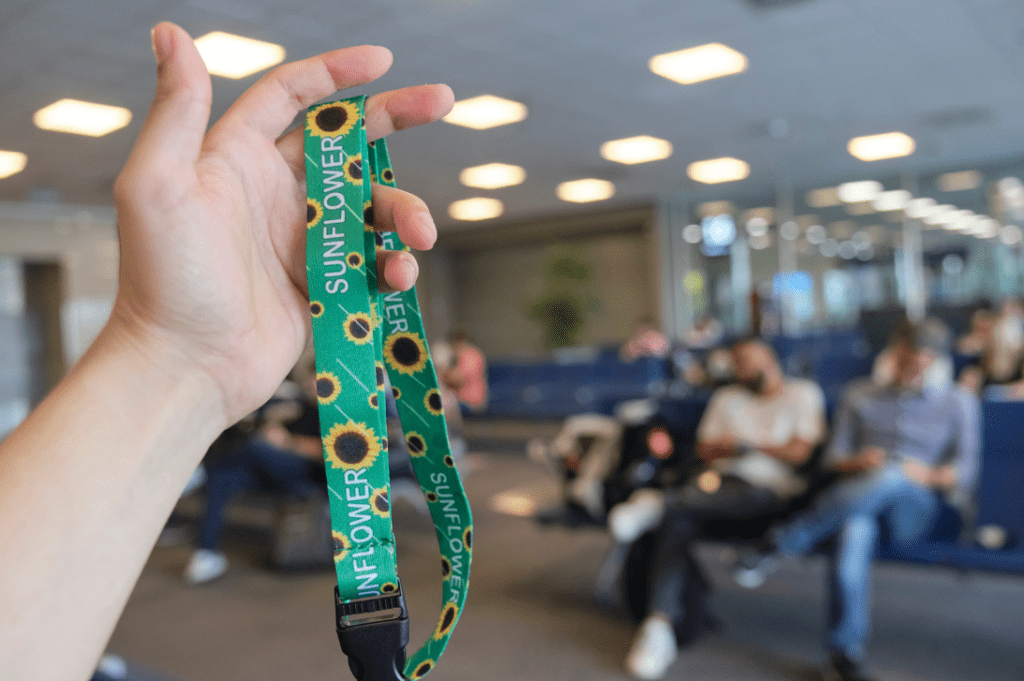The sunflower lanyard is an internationally recognised symbol. It’s aim is to discreetly show that the wearer has a hidden disability and may need extra assistance.
Why wear a sunflower lanyard?
Not everyone living with dementia needs assistance. But for those who do, it can be helpful to notify people, and particularly businesses, that they may need extra help and understanding. A sunflower lanyard only indicates that the wearer has a non-visible disability, it isn’t specific to dementia.Therefore, if you need assistance that is specific to someone living with dementia, it is always best to ask someone for help.
The lanyard in everday life
Unfortunately, living with dementia can make everyday living tougher than usual. Tasks that may seem easy to others can become increasingly difficult.
Whether it’s going to the supermarket and forgetting your shopping list, taking the bus to somewhere unfamiliar, or seeing your GP for a routine checkup, these scenarios can throw up hurdles to overcome. Wearing a lanyard can let others know that their assistance may be helpful. Whether it’s a member of staff, or a good samaritan, a lanyard will increase the likelihood of someone knowing when to step in and help.
How it can help on the train
Great Western Railways, Oxfordshire’s primary train provider, offers extensive support for those with non-visible disabilities. Lanyards should be available at all of GWR’s station ticket offices, or you can email their passenger assistance team to get yours: passenger.assist@GWR.com.
Those with a hidden disability can get special assistance when travelling with GWR. You will need to book assistance two hours prior to your journey. To do so, visit GWR’s website.
Every rail provider in the UK recognises the sunflower lanyard scheme. So no matter where you’re travelling by train, there will be a staff member that can help make the journey easier.

Hidden disability help at the airport
Airports can be overwhelming for people living with dementia. The constant noise, rush of holiday-makers, complex layouts, and general unfamiliarity can often lead to confusion. However, there are ways to make the journey easier.
Many UK airports have opted into the sunflower lanyard scheme, meaning they will be able to recognise and make extra acommodations for those living with dementia. They will also be able to provide you with a hidden disabilities sunflower lanyard if you haven’t got one of your own.
It is also common for airports to provide mobility buggys for help navigating. These can be used by people with mobility problems, but also those living with dementia, who might struggle to easily find their way around an airport.
Gatwick
Gatwick airport has a Special Assistance desk that is designed to make your trip as effortless as possible. The support at Gatwick includes:
- Special assistance lounges that allows for a peaceful wait prior to departure.
- Help points located throughout the airport.
- The ability to request for primary boarding and disembarking.
You can read more about the help you’ll get on Gatwick Airport’s website.
Heathrow
Heathrow airport has a Special Assistance desk that is designed to make your trip as effortless as possible. The support at Heathrow includes:
- ‘Host areas’ that have seating, flight information, and staff assistance.
- Help points located throughout the airport.
- An assisted shopping service.
- Dedicated assistant agents that can tailor the experience to your needs (booking required).
For a full view of the assitance provided see Heathrow Airport’s website.
Going abroad
The hidden disabilties lanyard scheme is available in many countries. Check the full list to see where you can make use of yours at: hdsunflower.com
Possible issues
Although sunflower lanyards are widely recognised in the UK, not every single person or business will know the meaning.
There are slight concerns that wearing a lanyard could lead to a safeguarding issue. Although there are many positives gained by making people around you aware of someone living with dementia, someone behaving in bad faith may try and exploit this. The lanyard is a helpful tool, but is no substitute for the care, love, and help given by all the carers, friends, and family of those living with dementia.
Going on holiday?
We have a whole page with helpful information designed to make travelling as easy as possible.
Further reading
The hidden disabilities lanyard scheme has a website where you can purchase various pins, badges, cards, and of course, lanyards.
A symbol for non-visible disabilities (hdsunflower.com)
